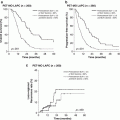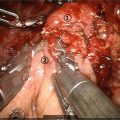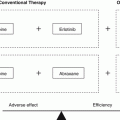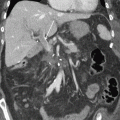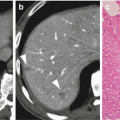Type of immunotherapy
Passive or active
Example
Advantages
Disadvantage
References
Adaptive cellular therapy
TIL
Passive
N/A
Limited TILs for in vitro expansion
A personalized approach and costly
N/A
CAR-T
Passive
Mesothelin
Can be produced in large scale
*A costly personalized approach
*Tumor-specific targets yet to be found
*Target limited tumor antigens
[33]
Cancer vaccine
Peptide
Active
MUC-1, survivin, telomerase, Ras mutant, VEGFR2
Low cost, high specificity
*Derived from weak antigen (TAA)
*Neoantigen yet to be identified
* Target limited tumor epitopes
[34]
DC-based
A good inducer of tumor-specific T cells
Whole Cell
GVAX, Algenpantucel-L
*Easy to manufacture
*Multiple and unknown tumor antigens targeted.
Trigger weak anticancer immunity
Checkpoint inhibitor
Active
CTLA-4, PD-1
*Target a broad spectrum of tumor antigens
*Does not need the knowledge of antigen identity
The anticancer effect relies on the immunogenicity of cancer
The following sections will summarize current major immunotherapy development in research and clinical trials, and their progresses in pancreatic cancer therapy.
16.3.1 Adaptive Cellular Therapy
Adaptive cellular therapy (ACT) is a procedure that aims to first expand T cells in vitro and then re-infuse the expanded T cell pool back into patients for cancer treatment [53]. Compared to peripheral blood of cancer patients, tumor infiltrated lymphocytes (TILs) are enriched in tumor-specific T cells and can be easily expanded in vitro by tumor cells with the presence of growth factors like interleukin-2 [54, 55]. This practice can generate tumor-reactive T cells with a broad range of tumor reactivity, without the knowledge of tumor antigen identities. With the improvement of culturing technology, the degree of expansion and quality control has been greatly enhanced. Isolating and expanding TILs for ACT is a very efficacious treatment strategy in melanoma [56]. However, the number of TILs that can be successfully recovered from the vast majority of solid tumors is very limited, especially for those cancers with few TILs. In addition, the majority of TILs display exhausted or dysfunctional phenotypes, which might cause the poor persistence of expansion tumor-specific T cell clones upon intravenous infusion [57, 58]. Therefore, the current approach of expanding TILs for ACT is mainly practiced in melanoma patients.
Genetically, engineering of lymphocytes is a new approach that aims to eliminate the obstacle posed by many tumors with a limited number of tumor-reactive T cells for ACT [52, 59, 60]. This strategy involves transducing immune cells with genes that redirect T cells to recognize cancer cells. The specificity of T cells can be redirected by the incorporation of genes encoding either conventional alpha-beta TCRs or chimeric antigen receptors (CARs) [61]. In this case, T cells from patient blood can be directly used as a source for ACT. CARs are constructed by linking the variable regions of the antibody heavy and light chains to intracellular signaling chains, such as CD3-zeta. The new generation of CARs is also composed of costimulatory domains of CD28 and/or CD137 to promote T cell expansion [62]. Because CARs are derived from antibodies, recognition of tumor-associated antigens (TAAs) by CARs is strong and is not restricted by major histocompatibility complex (MHC) [62].
However, a major hurdle for CAR-T therapy in human cancer is the identification requirement of appropriate tumor antigens that are exclusively expressed on the cancer cells, but not normal self-tissues. Most of the currently identified tumor-specific antigens are self-antigens that are normally expressed in early fetal development and that are aberrantly expressed during malignancy [63]. Examples include NY-ESO1 and the MAGE family antigens. The phenomenon known as “off-tumor, on-target,” where CAR-T cells recognize non-cancer cells expressing the tumor antigen, is responsible for severe immune-mediated toxicities that have limited the applicability of this treatment strategy [64, 65]. Therefore, careful monitoring and screening of targets for CAR-T therapy is extremely important. As a result, current successes of CAR-T therapy in clinic are mainly limited to certain types of lymphoma/leukemia [66]. Testing the feasibility of this approach can only be carried out in clinical trials, as preclinical models have proven to be insufficiently predictive of both efficacy and toxicity in humans. Whole-genome sequencing of cancer cells is generating abundant information about specific mutations in tumor cells, which may lead to the identification of tumor-specific antigens, also called neoantigens [67]. Innovative ways of generating antigen receptors that recognize these, including CARs that directly recognize intracellular molecules presented by MHC, may generate T cells with even greater specificities for tumor cells. It is worth noting that another potential obstacle for ACT is that the majority of the inoculated T cells die before reaching the cancer site, which can be a challenging obstacle for patients with solid cancers [68]. Therefore, selection of T cell subsets with better capacity for survival and proliferation is a critical step in ACT, and methods to selectively enrich central memory and stem cell memory T cell subsets from human lymphocytes may enable more effective anticancer responses in humans, similar to those observed in mouse models [68–70]. Although the range of CARs currently available is sufficient to cover most types of malignancy, tumor cells can lose the expression of TAAs to evade immune attack during ACT [60]. Therefore, using several CAR genes that target multiple TAAs simultaneously may be needed for future ACT to better accommodate the heterogeneity in human cancers.
Animal models of pancreatic cancer have shown encouraging results with the use of ACT [71, 72], and clinical trials using CAR engineered T cells for pancreatic cancer are currently ongoing in many cancer centers (NCT01897415, NCT02465983) [33]. The recently completed PDAC genomic analysis by Bailey et al. led to a deeper understanding of the molecular evolution of PDAC and to the identification of a specific immunogenic PDAC subtype [73]. This new and long awaited information may open the way to new and more accurate therapeutic targets for ACT.
16.3.2 Cancer Vaccines
Vaccine is an active therapeutic approach aiming to mobilize the immune system to generate or amplify tumor-specific immune response to combat cancer [74]. The primary mechanism for therapeutic cancer vaccines is to increase the presentation of tumor-associated antigens (TAAs) to the immune system, so as to mount a potent immune response against tumors. Cancer vaccines attempt to copy the achievements made in vaccinations against pathogens though more work is necessary to bring it to fruition. Based on the formats utilized, cancer vaccine can be classified into three major categories: protein/peptide vaccines, whole cell vaccines, and DNA vaccines [51].
16.3.2.1 Peptide Vaccines
Protein/peptide vaccines attempt to immunize patients with a peptide or a protein derived from cancer antigens in the formation of adjuvant or cellular vehicles. This strategy requires the identification of tumor-specific antigens or TAAs that are only expressed on cancer cells or overexpressed on cancer cells.
Peptide vaccine therapy for PDAC has been conducted in clinic for many years [34]. The most commonly used antigens in trials include telomerase, Wilms tumor gene, KIP20A, survivin, mutated Ras protein, mucin MUC1 protein, and vascular endothelial growth factor receptor 2 (VEGFR2). Though overall cancer vaccine is well tolerated, the outcomes of these vaccine trials have been disappointing with many lessons learned [34]. First, the presence of suppressive mechanisms at the cancer sites must be conquered. Immunoconditioning can eliminate some of these immunosuppressive mechanisms, but at the same time it also dampens endogenous anticancer immunity that is needed for cancer vaccines. Examples of cells responsible for this suppressive mechanism include Treg cells, MDSCs, as well as the signal generated through the interaction between PD1 and PD-L1 at the cancer site [75, 76]. Second, the antigen/peptides used in trials are mainly tumor-associated antigens (TAAs), which may be well tolerated and thus incapable of triggering anticancer immunity strong enough to destroy PDAC [77]. Emerging data in clinical immunotherapy suggest that the recognition and response to neoantigens, which arise as a consequence of tumor-specific mutation, is the major player, and neoantigen loads correlate with overall response rates to therapy [67]. Recent technological advancements have made it possible to dissect the immune response to patient-specific neoantigens [78]. It remains to be seen whether a neoantigen-based vaccine is capable of triggering potent anticancer immunity for cancer therapy.
16.3.2.2 Whole Cell-based Vaccines
Whole cell vaccines are conceptually easy to understand as this strategy, as the name indicates, proposes to utilize the whole tumor cell to elicit a specific anticancer immune response [79]. The tumor cell can be either autologous (i.e., patient-specific tumor cell) or allogenic (i.e., established human tumor cell line). The rationale for this approach is that cancer cells express the entire spectrum of tumor antigens (i.e., for that specific tumor in that specific patient) as well as specific epitopes for CD8+ and CD4+ T cells that can be presented to the patient’s immune system [80]. This approach is considered polyvalent (as it presents a wide range of tumor antigens to the immune system) and therefore, at least in theory, it is less susceptible to tumor immune evasion as seen in peptide-based vaccine (i.e., where mutation of TAAs under selective pressure leads to loss of the immune target). In addition, this approach is applicable to cancers even without the knowledge of antigen identity [80]. In the autologous approach, tumor cells are required to be isolated from the patient, irradiated, combined with an immunostimulating agent and ultimately infused back into the patient [79]. Therefore, this technique is limited by the availability of sufficient tumor sample that at times can be difficult to obtain, especially in certain cancer types. In this case, allogenic cell lines offer a valid alternative, as they are readily available and can be produced on a large scale [81].
GVAX is an allogenic irradiated whole cell vaccine composed of two irradiated cancer cell lines (PANC 6.03 and PANC 10.05) engineered to express granulocyte macrophage-colony stimulating factor (GM-CSF) [39, 40]. GM-CSF is a potent cytokine that functions to promote the growth of granulocytes and monocytes and also to attract dendritic cells for better antigen presentation. GVAX alone or in combination with other therapies has been investigated in multiple phase I and II studies [41–43]. A phase I trial of GVAX in 14 patients with resectable pancreatic cancer showed a mean disease-free survival (DFS) of 13 months, with three patients disease-free from 25 to 30 months [44]. Though a following phase II trial of GVAX in combination with cyclophosphamide (CY) in patients with metastatic pancreatic cancer failed to show improvement of overall survival (OS), a higher rate of induced mesothelin-specific T cell responses could correlate with longer progression-free survival (PFS) and OS [41]. Similarly, a phase II study of patients with resected PDAC using GVAX plus chemoradiation displayed median DFS of 17.3 and median survival of 24.8 months. This demonstrated an association between mesothelin-specific T cell induction and improved overall survival [42]. GVAX also has been tested in combination with Live-Attenuated Listeria monocytogenes (CRS-207), in an attempt to use the ability of Listeria to stimulate both innate and adaptive immunity to ultimately boost the overall response to the cancer vaccine [45, 46]. In a recent phase II trial, the authors showed a 2-month improvement in overall survival in patients treated with GVAX–cyclophosphamide and CRS-207, compared with GVAX–cyclophosphamide (median 6 months vs. 4 months; HR 0.60; P = 0.02) [46]. Based on that, it is anticipated that a larger study of the GVAX/CRS-207 combination on patient survival will launch soon.
Algenpantucel-L is another major whole cell cancer vaccine being developed for PDAC [47]. It is composed of two human pancreatic cancer cells expressing the enzyme alpha-1, 3-galactosyl transferase (αGT) [48]. Humans lack a functional αGT gene and are not tolerant to αGT; therefore, αGT-labeled tumor cells could lead to enhanced antitumor response, as has been demonstrated in mouse tumor models [82, 83, 84]. In an open labeled, phase II trial of algenpantucel-L with gemcitabine and 5-fluorouracil (FU) for patients with resected PDAC, 12-month DFS of 62% and OS of 86% were achieved as compared to historical controls (45% and 65%, respectively) [48]. Another positive sign was that patients with algenpantucel-L therapy experienced minimal side effects, mainly consisting of injection site pain and induration. Based upon these encouraging results, a phase III study in patients with surgically resected PDAC was launched in 2010 [NCT01072981]. Another ongoing phase III trial (ClinicalTrials.gov: NCT01836432) involving Algenpantucel-L in PDAC is to combine with FOLFIRINOX or gemcitabine/nab-paclitaxel, and results of the trial are expected to be released in June 2017.
16.3.2.3 DC and DNA Vaccine
Similar to peptide vaccine, DC and DNA vaccines require the knowledge of TAAs or neoantigens. Genetic vaccine consists of a DNA-based vaccine that aims to introduce genetic material into a live host [85]. This allows the chosen gene products to be expressed and ultimately triggers a specific immune reaction to the gene-derived antigen. The advantage of a genetic vaccine is that it allows the expression of antigens that resemble native viral epitopes more closely than live-attenuated or killed vaccines that often alter the protein structure and antigenicity [85]. DCs are one of the most effective APCs which function to process and present antigens on MHC molecules to trigger T cell responses [86]. DC vaccines use DCs as a vehicle for peptide/DNA vaccine, and this strategy has the potential of bridging the gap between innate and adaptive immunity [87]. This approach requires isolation of patient’s DC that are eventually pulsed with peptides, and finally injected back to the patient. A successful example of peptide vaccines is Sipuleucel-T, the first FDA-approved drug for the treatment of hormone refractory prostate cancer, which is capable of extending the overall survival of cancer patients [88].
Early clinical trials of PDAC patients demonstrated that DC vaccine is well tolerated and capable of inducing detectable antigen-specific immune response in patient blood though no clear clinical benefit is observed [35]. In a phase I/II study, Lepisto and colleagues evaluated the use of an MUC1 peptide pulsed autologous DC vaccine as adjuvant therapy in patients with resectable pancreatic and biliary tumor [36]. In this study, patients were followed for over 4 years and 4 out of the 12 enrolled patients (10 had pancreatic cancer) were alive and without any evidence of recurrence. Other TAAs, such as CEA and hTERT, were used for early clinical trials of DC vaccine, with only minor objective clinical responses reported [37, 38]. Because neoantigens are more immunogenic and trigger a more potent immune response in cancer patients, the future development of DC vaccine for PDAC will likely utilize neoantigen-based DC vaccine.
16.3.3 Immune Checkpoint Inhibitors
T cell response is largely controlled by an array of cellular surface signaling molecules, also known as cosignaling molecules [89]. Modulating these cosignaling pathways increases anticancer immunity, either through the amplification of costimulatory pathways or blockade of negative signals, also known as immune checkpoints [90]. The major immune checkpoints under clinical investigation include at least CTLA-4, PD-1, TIM-3, LAG3, and TIGIT [91, 92]. Many of the ligands for immune checkpoints are upregulated at cancer sites and contribute to the induction of tumor-specific T cell exhaustion/dysfunction at cancer sites [91, 93]. Using monoclonal antibodies or fusion proteins are the main strategy to block or amplify cosignaling pathways. The immunomodulation strategy strives to promote or liberate internal anticancer immunity in a patient with an established cancer [94]. One of the advantages of this therapeutic strategy is that immunomodulation does not require the knowledge of specific cancer antigens but rather focuses on the manipulation of known leukocyte receptors. These provide several potential therapeutic targets that are characterized by a broad spectrum of antigen diversity that could ultimately avoid the mechanism of cancer immune evasion, caused by mutation of cancer-specific antigens [95].
Targeting immune checkpoints has been a major breakthrough in cancer treatment in recent years [96]. CTLA-4 is transiently expressed on the T cell surface upon activation and attenuates ongoing T cell response by competing ligands B7-1 (CD80) and B7-2 (CD86) with the costimulatory receptor CD28 [97, 98]. In addition, CTLA-4 also transduces a suppressive signal to T cell via the recruitment of phosphatases SHP-2 and PP2A [90]. Ipilimumab, an anti-CTLA-4 mAb, is the first FDA-approved immunotherapy drug to treat patients with late-stage melanoma [99, 100]. Administration of ipilimumab activates T cells systemically, leading to extensive antitumor immunity and therefore a survival benefit in 10–15% of patients with advanced metastatic melanoma. Furthermore, this antitumor response significantly increases overall patient survival in advanced melanoma cases [99]. However, antitumor activity is frequently accompanied by significant immune-related adverse events. PD-1 is another inducible immune checkpoint on T cells that suppresses T cell response upon interaction with its two ligands, PD-L1 (B7-H1) and PD-L2 (B7-DC) [36, 101]. The PD-1 pathway is heavily involved in the immunosuppressive cancer microenvironment: PD-1 is highly expressed in TILs while the ligand PD-L1 is found on tumor cells, tumor-associated DCs, macrophages, and fibroblasts [94, 102]. Targeting the PD-1 pathway has elicited durable antitumor responses and long-term remissions in patients with a broad spectrum of cancers. The objective response rates varies in different cancer types, with bladder cancer, melanoma, mismatch repair-deficient colorectal cancer and certain hematopoietic malignancies among the most responsive cancer types [102]. Compared to CTLA-4 blockade, the antitumor efficacy of PD-1 blockade is higher, and the side effect is significantly milder and manageable [49, 103–105]. Currently, PD-1/PD-L1 mAbs have been approved by FDA to treat late-stage melanoma, non-small cell lung cancer, and kidney cancer [102]. It is anticipated that PD-1 mAb will be approved for treating more cancer types and become the frontline therapy for future cancer treatment.
Ipilimumab alone, or in combination with peptide vaccine, did not have any clinical benefit in treating PDAC patients. In a phase II trial of 27 patients with advanced PDAC, single-agent ipilimumab failed to detect any responder by response evaluation criteria in solid tumors [50]. However, a significant delayed response in one subject of this trial suggests that this immunotherapeutic approach to PDAC deserves further exploration [50]. With tremendous success in many cancer types, early trials of anti-PD-1 mAb alone showed no effect in treating patients with advanced PDAC, though the number of patients in the study was small [49]. PD-1 mAb alone is ineffective in treating cancers with few neoantigen loads [49]. PDAC happens to be a low immunogenic cancer [31]. It is not surprising that targeting immune checkpoints alone is incapable of launching an effective anticancer immunity in PDAC patients. Therefore, additional procedures are needed to increase the number of TILs surrounding PDAC cancers, so as to prime PDAC for immune checkpoint therapy [106].
16.3.4 Combined Therapy
The low immunogenicity and unique stromal structure of PDAC cancer poses a great challenge for immunotherapy [22]. The disappointing outcomes in clinical trials using single-agent immunotherapy propel the launch of combinatory approaches. Combination therapy targets more than one aspect and can be classified as the combination of two different arms of immunotherapeutic approaches, or the combination of immunotherapy with traditional therapy (chemotherapy or radiotherapy).
Examples of combinatory approaches that combine two different arms of immunotherapy could include the combination of cancer vaccine with immune checkpoint blockade or the simultaneous use of both active and passive immune therapy. Immune checkpoint inhibitors alone are not effective in the treatment of PDAC, much due to the lack of tumor-infiltrating T cells at tumor sites [23]. Cancer vaccine is known to be a very efficient method of expanding tumor-reactive T cells, while blockade of immune checkpoints will further promote antitumor immune responses at tumor sites. In fact, several preclinical studies exist that demonstrate the synergistic role of cancer vaccine therapy, which is responsible for stimulation of the immune system, and the use of immune checkpoint blockade, which allows for the unopposed effector function of cytotoxic T cells [107–109]. Consistently, clinical examination of resected PDAC tumors demonstrated that vaccine therapy can alter the immunosuppressive cancer microenvironment [106]. The majority of PDAC patients receiving GVAX vaccine had vaccine-induced intratumoral tertiary lymphoid aggregates in resected tumors, accompanied with increased intratumoral Teff/Treg ratios [106]. As such, a phase Ib, open-label randomized study demonstrated the feasibility and safety of an approach based on the combination of Ipilimumab with GVAX in patients with previously treated PDAC [47]. One of the most interesting aspects of this study was the difference in 12-month OS: 27% vs. 7% and the median OS: 5.7 vs. 3.6 months (HR = 0.51; P = 0.072), respectively, for combination therapy vs. monotherapy (i.e., Ipilimumab alone).
Given that PD-1/PD-L1 blockade is safer and more effective than CTLA-4 blockade in the treatment of many cancers, it is interesting to see how the combination of GVAX with PD-1/PD-L1 blockade performs in the treatment of PDAC [104]. Interestingly, PD-L1 expression was observed in all these lymphoid aggregates in GVAX-treated PDAC patients [106]. Currently, a phase I/II study with GVAX and anti-PD-1 mAb (nivolumab) has started to recruit patients with PDAC (NCT02451982). Similarly, a randomized phase II trial of GVAX and CRS-207 with or without nivolumab has also launched (NCT02243371).
Combinational therapy involving PD-1/PD-L1 blockade has also been investigated with chemotherapy or radiotherapy in PDAC [110]. These approaches are based on the observation that chemotherapy or radiotherapy can kill cancer cells to increase the supply of tumor antigens for presentation, so as to promote tumor-reactive immune responses [111–113]. In addition, many conventional cancer treatments in chemotherapy and radiotherapy have immune potentiating mechanisms of action, such as the elimination of immunosuppressive cells, including Treg and MDSC (Zitvogel L, JCI 2008). A phase I trial (NCT02303990) of pembrolizumab (anti-PD-1 mAb) with the combination of hypofractionated radiotherapy has started to treat patients with metastatic pancreatic cancer. In another phase I study of PDAC (NCT02546531), PD-1 blockade (pembrolizumab) is proposed to be combined with gemcitabine and defactinib, an inhibitor of focal adhesion kinase (FAK), which promotes stromal fibrosis. Because immune effector cells are also sensitive to chemotherapy and radiotherapy, early phase clinical investigations into optimizing dose and schedule in patients are necessary.
16.4 Perspective
Despite recent advancements in PDAC treatment modalities, modest success has been achieved and the curative goal remains unmet. Surgical resection remains to be the only potential cure for early-stage PDAC. Immunotherapy emerges as a promising treatment for metastatic PDAC, with the potential of targeting disseminated disease as well as preventing cancer recurrence. With the technological advancement in genome sequencing, neoantigens in PDAC will be identified as better targets for vaccine therapy or ACT. Together with further interrogation of the PDAC microenvironment, it is promising that more PDAC immunosuppressive mechanisms, by which PDAC evades immune attack, will be revealed for future immune interventions.
Early clinical trials in immunotherapy also demonstrated that the complexity of the PDAC microenvironment and the formidable immunosuppressive nature of this cancer might require a combination of different therapeutic strategies [110]. These therapies need to be able to simultaneously target the stroma-cell population, where the tumor cells locate, as well as the cytotoxic T lymphocytes (manipulating different immune checkpoint inhibitors) or directly the tumor cells (traditional chemotherapeutic, vaccination, ACT). For instance, besides cancer vaccine, other therapeutic approaches, including chemotherapy, radiotherapy, and ACT may prime PDAC to become susceptible for immune checkpoint inhibitor therapy. Moving forward, the focus of modern clinical immunotherapy will be to identify the most efficacious, synergistic therapy that is able to obtain the maximum antitumor activity with the least systemic toxicity. Finally, it is imperative to identify reliable biomarkers to predict tumor susceptibility to immunotherapy in clinic, to identify those patients that are more likely to benefit from this unique therapeutic approach.
References
1.
Finn OJ. Immuno-oncology: understanding the function and dysfunction of the immune system in cancer. Ann Oncol. 2012;23(Suppl 8):viii6–9. PubMed PMID: 22918931. Pubmed Central PMCID: 4085883 PubMedPubMedCentral
Stay updated, free articles. Join our Telegram channel

Full access? Get Clinical Tree



